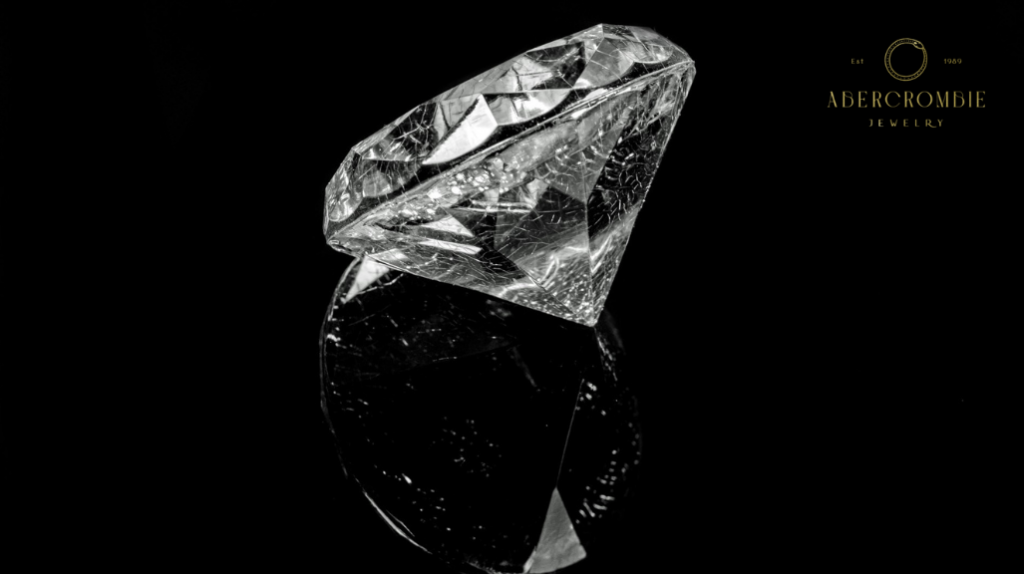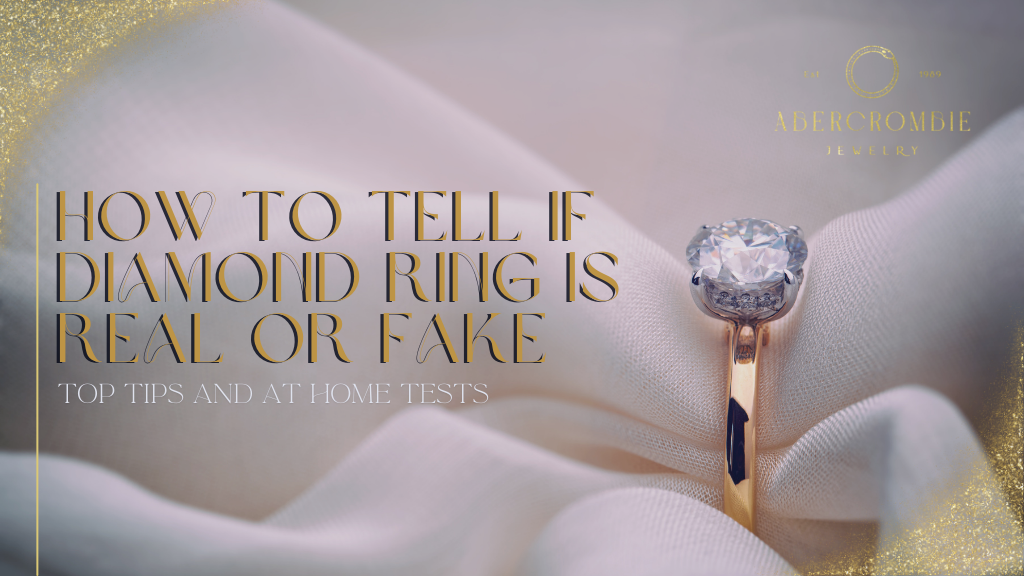Wondering how to tell if a diamond ring is real or fake? Abercrombie Jewelry presents top tips and at-home tests to help you verify your diamond’s authenticity. Whether you’re considering a purchase or want to confirm the quality of your existing jewelry, this guide will provide you with the knowledge and tools you need to make an informed decision.
You would not be the first or last person to look at the sparkly stone on their finger and wonder if it is, in fact, a diamond. Natural diamonds are one of the most desirable stones of all, and nobody wants to walk around believing theirs is the real deal if it is not.
Many convincing diamond substitutes are tough to tell from the real thing unless you know what you are looking for. While there is nothing wrong with wearing a diamond substitute, it is unsettling if you are told it is genuine but are not convinced.
Luckily, a genuine diamond has a few tell-tale qualities that cannot be replicated to perfection- and there are tests you can do at home that could tell you whether or not your diamond is real.
This guide to real diamonds, fake diamonds, and how to tell the difference offers solutions for testing mounted and loose diamonds at home. Remember- some diamond alternatives may pass some tests, so you might have to run more than one!

Read Next: What Is a Diamond Appraisal? A Comprehensive Guide
What Materials are Often Used to Make a Fake Diamond?
Before we get into tips for testing a diamond’s authenticity, let’s discuss some of the most common materials used to create synthetic diamonds or that are sometimes mistaken for the real thing.
Cubic Zirconia
The most popular choice of synthetic diamond is cubic zirconia. At just $20 a carat and a reasonable hardness score of 8.5 (compared to 10 for diamonds), cubic zirconia is a fan favorite for those who want the overall appearance of a diamond without the price tag.
Zircon
Despite the similarity in name, zircon is a very different substance to cubic zirconia. It is more expensive, for starters- but still significantly cheaper than a diamond. Zircon is a hard mineral that has a lot of the same brilliance and dynamic shine.
Moissanite
Moissanite crystals are widely considered the best diamond simulants. They have a hardness score of 9.5 and shine as brilliantly as genuine white diamonds- but are not quite as indestructible. At around $270 per carat, they are valuable stones in their own right.
Glass
The cheapest and most readily available diamond substitute is glass. It looks pretty convincing from a distance, but one close look leaves little question of its authenticity. Glass has a much duller sparkle than diamonds and is half as hardy. Scratches, bubbles, and dents are all easy giveaways with this one.
White Sapphire and White Topaz
White sapphire and white topaz have similar aesthetic qualities to diamonds and are often used as alternatives. Although not often passed off as a diamond, either stone could, in theory, be mistaken for one.
Of the two, sapphire is more convincing, but white topaz is more durable. Both shine beautifully but dull faster than diamonds and do not have the same depth of color when they interact with light.

Tips for Telling if Your Diamond Is Real
Look at How it Sparkles
The sparkle test is the first thing people look at to spot a natural diamond. Diamonds give off white light sparkle and colored light sparkle, so you get bright brilliance and rainbow.
No rainbow- or an overpowering amount- is usually a bad sign. A stone that looks dull or one-dimensional is also probably not real.
Check if There are Any Scratches
Most people don’t want to do a scratch test on their stone (purposely attempting to scratch the surface with stainless steel), but anyone can have a look to see if there are already some existing marks.
A real diamond is extremely hard and does not scratch, so if you notice marks, dents, chips, or lines- the stone is probably fake.
Inspect it With a Magnifying Glass
Flawless diamonds are rare and expensive and don’t appear in many engagement rings or publicly-sold jewelry. Because of this, you can often tell if a diamond is fake if it looks too perfect. Use a magnifying glass to spot imperfections.
Perfect may sound appealing, but in this case- it is usually too good to be true.
Five At-Home Tests to Tell the Difference Between Fake Diamonds and Real Diamonds
The Black Light Test
An effective way of spotting the difference between real and fake diamonds is the black light test (also called the UV light test). It requires a UV light and a dark room.
Turn off the lights, turn on your UV light, and hold the diamond in front of it.
A blue-colored glow is what you want to see if you are hoping for confirmation that your diamond is real. Unfortunately, this only applies to most diamonds, not all of them.
The shade of blue can vary from mid-range to strong- but you don’t want to see a slight green tinge or yellow or grey tones. These colors suggest the stone is a gem of other material, not a diamond.
Remember, not all diamonds give off a blue fluorescence under UV light- only about 95% of them. The next most common color is yellow, but this is quite rare.

The Dot Test
Because diamonds refract light, you can’t see images through them. An example of how to show this is by drawing a small dot on a piece of paper and placing your diamond over it.
With a genuine diamond, the image is refracted- so it becomes invisible through the stone. You will still be able to see it at least partially through synthetic cubic zirconia, glass, or other diamond impostors.
The Fog Test
A fast and easy way to spot a fake stone is to breathe on it the way you would before cleaning the lenses on a pair of glasses. The more it fogs and the longer the fog lasts, the more likely it is to be fake.
If a diamond is real, it will remain completely clear or only slightly fog for a split second. A high-quality diamond should not fog at all.
Noticeable fogginess that lasts for two or more seconds is a sign of a fake diamond.
The Heat Test
The heat test is a pretty reliable method for testing whether or not a diamond is real- but it is a little risky. If the diamond is genuine, you have no problem- the issue is when the stone is made of something else.
Disclaimer: This test will not just prove that a stone is not a real diamond- it will destroy it in the process.
In short, this test works by putting the stone under pressure by switching from extreme heat to cold. You hold the stone over an open flame for around 45 seconds, then drop it into a glass of chilled water.
This, for a diamond, is no biggie- it is more than tough enough to come out unscathed. All other materials are very likely to shatter or at least crack.
The Water Test
The water test is quite telling if you are testing a loose diamond. Because of how dense a real diamond is, it will sink to the bottom. By the laws of physics, if a stone floats in water or hovers in the middle, it is not a diamond.
Here’s the thing- this is not 100% foolproof. While there is no doubt that any stone that floats even slightly is not real, there is a chance that some fake diamonds could also sink. It depends on what they are made of- some other synthetic diamonds could include materials heavy enough to sink to the bottom.
If your stone floats, it is not real. If it sinks, it may be worth trying out another test.

Still Unsure? Take it To a Jeweler
As insightful as these at-home diamond tests are, most can still leave some doubt in your mind. If you are still unsure after performing the tests you can manage by yourself, it is best to seek professional advice.
Any reputable jeweler that works with diamonds should be able to tell you almost immediately if a stone is a real diamond or not. They have special tools, know exactly what to look for, and can spot a fake diamond easily
The methods they use are not just basic tests- they look closely at the diamond’s structure using a super-detailed magnifying glass.
It is the best solution if the results do not convince you of home tests or need to know with absolute certainty for whatever reason.
Summary
You can test whether or not your diamond is real at home in a few different ways, but remember that some results are not 100% accurate or reliable. Most of the tips and tests on this list can give you a pretty good idea, but if you are in doubt, have the diamond inspected by a professional.
Remember, diamonds are harder and more brilliant than other stones- so if yours seems chipped, scratched, or dull, there is a chance it may not be real. Some diamond simulants are more convincing than others, but nothing is quite as impressive as the real thing.

